by Winding Pathways | Mar 12, 2020 | (Sub)Urban Homesteading, Garden/Yard, Garden/Yard
Like millions of Americans who live in rural or semi-rural areas we don’t have access to a city sewer and rely on our septic tank to safely dispose of waste. We’re lucky at Winding Pathways. Our home is built on an ancient sand dune with steep topography. It’s perfect for a septic system.
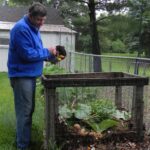
We put scraps that chickens will not eat into the compost bin.
As a review, we’ve been spared septic tank problems because we treat our system carefully. Here’s what we do:
- Only human and sink waste goes down the drain. Potato peels, apple cores, and all other food waste go either to our chickens or into the compost bin. Spring and fall, we work the compost into the garden soil.
- Have our tank pumped every three or four years.
- Avoid draining harsh chemicals, like bleach and solvents, into the tank.
- Use water-efficient toilets, showerheads, and sink aerators to limit the amount of water going into the tank.
In August 2019, we blogged in detail about maintaining a septic system. Since then, many readers have come to that blog. Especially this winter. So, we are curious.
What brings you to Winding Pathways? What topics interest you most? Why? What else would you like to read about?
Thanks for keeping us company on Winding Pathways and happy reading as winter winds down and spring manifests itself across the Northern Hemisphere.
by Winding Pathways | Feb 20, 2020 | (Sub)Urban Homesteading, Garden/Yard, Garden/Yard, Labyrinths, Nature
When we moved into our home ten years ago, we ended up with more than a house. The former owner had regularly mowed most of our two acres. Within the next two years, we shrank the lawn by about half. A steep former lawn north of the house is now prairie and a fairly level quarter acre between our house and the road is Marion’s labyrinth that she created within a prairie we planted.
Today, most people call flower-studded prairies “pollinator patches” and interest is strong in transforming lawns into them. Here are just a few of the good reasons:
Why Plant Pollinator Patches?
- Color: Lawns are a monoculture of green. Pollinator patches feature three seasons worth of changing vibrant color as many species of wildflowers come into and go out of bloom. They are beautiful.
- Water: Closely mowed lawns don’t absorb rain well. Much of a storm’s water runs off, worsening flooding. In contrast, deep-rooted prairies channel most of a storm’s water into the soil, where it eventually recharges the water table and doesn’t worsen downstream flooding.
- Labor: We don’t enjoy endless hours walking behind a lawnmower. We will mow our newly planted prairie two or three times this summer and in the following years, we won’t mow it at all. The lawn takes about a dozen mows a year. So, we’re saving time and mower gas that costs money and creates carbon dioxide.
- Wildlife: We love watching our wren pairs forage for insects in our pollinator patches. By expanding our prairie we’ll welcome even more beautiful and interesting beneficial wild animals to our yard.
Partnerships Work!
Our new prairie will be close to busy 30th St. Drive, so motorists cruising by will see the land transform. We’re partnering the project with the Monarch Research Project, Linn County Roadsides, Sustainable Landscape Solutions, and Pheasants Forever.
Many people want to create pollinator patches in their yards but don’t know how to do this. We will be blogging through the process to help folks know how this is done. Stay tuned and keep visiting www.windingpathways.com to learn how.
-
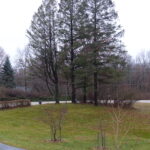
-
The heavy, up-slope clay soil will absorb water more efficiently and reduce runoff.
-
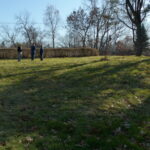
-
The crew from Sustainable Landscape Solutions determine soil type
-
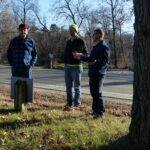
-
Winding Pathways, Linn County roadsides, Pheasants Forever, the Monarch Research Project and Pheasant Forever make a strong partnersjhip demonstrating how to improve the quality of the land.
-
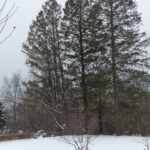
-
This year snow covers the lawn.
by Winding Pathways | Jan 9, 2020 | (Sub)Urban Homesteading, Garden/Yard
Savoring Seed Catalogs
There’s a surefire way to tell we are in the depths of winter. It’s the arrival of garden seed catalogs in the mail. We get many at Winding Pathways.

Seed catalogs make great winter reading.
Some come from massive companies that sell a wide range of flower and vegetable seeds plus tree seedlings and garden supplies. Others are from companies that specialize in one type of seed or plant, like fruit tree seedlings or prairie plants.
We buy vegetable seeds in late winter from either the Dutchman’s Store in Cantril, Iowa, or the Stringtown Grocery near Kalona, Iowa. Both are run by Mennonites or Amish people and sell bulk seeds. Scoop a spoonful from a large jar and deposit them in a small envelope. Then write the code and vegetable name on the envelope and pay on the way out. We’ve found the seeds to be of excellent quality and much less expensive than similar ones sold in stores or through catalogs or the computer.
Not everyone has access to a bulk seed store, so buying prepackaged seeds makes sense. Sometimes seed catalogs list vegetable varieties we want to try and can’t get otherwise. This year, for example, we will plant a new dwarf winter squash. The vines are short and the fruits just the right size for two people.
We usually buy trees from the National Arbor Day Foundation, and prairie plants from Prairie Moon Nursery. Arbor Day Foundation trees are small but we’ve had excellent results from them, and they are inexpensive.
In early 2020 we plan to convert about 3,000 square feet of lawn to low profile pollinator habitat. We’ll buy a prairie seed mix from Pheasants Forever (pfhabitatstore.com). They have many mixes available that are suitable for different soils. They are most appropriate for larger areas.
Happy Planning and Planting.
by Winding Pathways | Oct 31, 2019 | Bugs, Garden/Yard, Nature
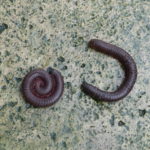
Millipedes are ancient creatures
Many people discovered one of the oldest types of animals in their yards and homes this year. Millipedes. Usually common they have been especially visible in this humid rainy summer and fall.
Millipedes have been around for millions of years doing the world a service. Biologists call them detritivores, which simply means they eat bits of decaying leaves, grass, feces, and other organic matter found nearly everywhere. Scientists call dead material of many origins detritus. To millipedes it’s dinner.
About 12,000 species of millipedes live around the world on all continents except Antarctica. They range from about a quarter-inch to several inches long and most are brown or black. All have two pairs of legs on each body segment. Since they have many segments millipedes have enormous numbers of legs stretching down each side of their body. That doesn’t make them speedsters. Millipedes creep along.
Few animals are as harmless as millipedes. They can’t bite or sting. When threatened millipedes roll up in a ball and play possum, but normally they avoid predators by hiding in detritus or under rocks and logs. Snakes, amphibians, and birds enjoy snacking on them.
Millipedes are sometimes confused with centipedes, but they are distinctly different. Millipedes are sluggish consumers of dead plants while centipedes are swift predators. Both enter homes through cracks and holes in the walls or gaps in doors and windows. Caulking is an effective way to keep them outside.
Millipedes may seem creepy to some people but they have survived for millions of years recycling dead plant material into humus. They deserve our respect.
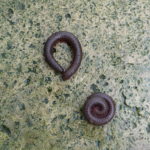
Can you count the millipede legs?
Answer: Millipedes take so long to lace up their shoes that the race is over by the time they finish.
by Winding Pathways | Aug 22, 2019 | Chickens, Garden/Yard
We were delighted when our Lavender Orpington hen started acting strangely. She fluffed up her feathers, spent most of her time in a nest box, and gave us a stern warning call if we came too close. She was broody.
A broody hen simply wants to be a mother. Her ambition is to keep a clutch of eggs warm for 21 days and then raise a bunch of bouncy babies to chicken adolescence. We don’t have a rooster so all of our hen’s eggs are infertile and won’t hatch. Broody doesn’t know this, but we found a way to have her happily raise a brood of chicks.
After about two weeks of incubation, we bought a dozen chicks from a local farm store and slipped them under her after dark. Motherhood commenced.
Watching a mother hen is interesting but listening is truly fascinating. While on eggs she sat almost trancelike, but the peeping awakened her. She began clucking in a tone that must have both comforted the downy chicks and instructed them to get into the warmth and security of her feathers.
The next morning she used a different clucking tone to introduce the babes to the big world. They followed her out of the nest and scampered around the coop. We don’t speak “chicken” but she clucked again and it must have meant, “come over here and eat.” She put her beak in a feeder filled with chick starter. The bravest babies picked a few crumbs of feed off her beak and soon all were eating and dipping their beaks into a nearby waterer for a cool drink.
Mother hens are attentive and have a vocabulary of many “words” or at least different sounding clucks. When the babes got too far from her she’d cluck in a certain way bringing them scampering back to safety near or under Mom. If she scratched up a delicious tidbit she’d utter a different sounding cluck and the babies would rush over and enjoy a food new to them. She taught them safety and the fine art of foraging.
-
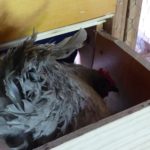
-
Lavender Orpington wants to be a mother!
-
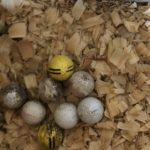
-
A mama hen will sit contently on golf balls until new chicks arrive.
-
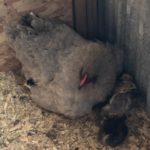
-
Babies gather round Mama Hen at night.
See these YouTube videos and photos of our most recent broody and foraging for treats.
Tucking in for the Night
Under Mama’s Watchful Eye
Babies Eating Corn
At the Gate Waiting for Treats
Treat Bucket
Feasting on Corn
by Winding Pathways | Jul 11, 2019 | (Sub)Urban Homesteading, Garden/Yard, Trees
Early one May afternoon we arrived home, glanced into the woods past our property, and were astonished to see an enormous red oak on the ground. The tree looked healthy, solid, and unlikely to topple, but it fell on a clear calm day. On its way down the old veteran broke two younger trees growing nearby.
A week or so later we woke to an enormous crash. It was pitch dark so we were only able to search around with a flashlight to learn that nothing had hit our house. The next morning, we discovered a giant elm prostate on the ground about 150 feet from our bedroom on a neighbor’s property. Like the oak, it fell when it was calm. Unlike the oak, the elm had been dead for years and many mushrooms were growing from its trunk.
We enjoy a huge diversity of birds and other wildlife in our yard, in part because we adjoin Faulkes Heritage Woods, a 110 wild forest protected by a conservation easement. The Woods have not been logged for over a century, so many enormous oaks, hickories, and maples live there. Many are dead or in decline, but that’s great for wildlife.
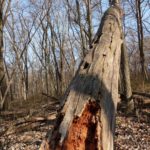
Dead trees provide food and nesting sites
Of all landscape features few are as valuable to as many wildlife species as an old dead tree. Nearly as soon as a tree dies insects, bacteria, and fungus begin the long process of recycling wood and bark back into humus. Woodpeckers drill into dead trees to extract tasty insects and carve out nesting cavities. Often their old cavities are used by chickadees, wrens, and many other cavity nesters. Dead trees are favored perching sites for raptors, perhaps because they are leafless, so the sharp-eyed birds can spot prey on the ground.
We let dead trees stand on our property, as long as they are far enough away from the house so they can’t cause damage or injure someone when they crash down.
Are Dead Trees Dangerous
We’ve been in the right place at just the right time to see big trees fall. Usually, there’s a crack or two before a giant tree crashes down with lightning speed. If someone were underneath it then it would be hard to run fast enough to escape injury.
The odds of a person being hit by a falling tree while walking along a trail are infinitesimally small. It almost never happens. Most injuries and fatalities occur when people camp, picnic, or sit under a tree. The risk comes because they are under the tree for hours while sleeping or in a position where they can’t run and escape quickly.
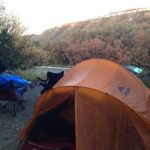
Look up when placing your tent near trees.
Before setting up a tent always look up and never pitch it under a weak or dead tree that could fall in the night.
How to Tell If A Tree Is Likely to Fall
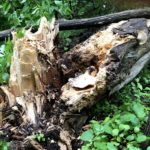
It’s a wonder this tree stood as long as it did.
Determining if a tree is likely to fall isn’t always easy. Sometimes seemingly healthy strong trees fall over, but often one gives notice that it is in decline and weakening. Here are visible signs that a tree is vulnerable to falling:
- It’s dead. No leaves. Branches occasionally dropping off. Bark sheathing off.
- It’s alive but increasingly branches are dying and are bare of leaves.
- Mushrooms are growing from the wood.
- Little piles of sawdust at the base show that insects or woodpeckers have been at work.
- It’s old. As trees age, they stiffen and eventually, their wood weakens. Young healthy smaller trees are more flexible and bend back and forth in heavy wind without damage. Wind can crack the wood of old stiff trees.
- All trees eventually fall down but some have notoriously weak wood that breaks easily. Silver maples, black locust, and Siberian Elms often shed big limbs or break during storms.
Should I Have A Tree Taken Down?
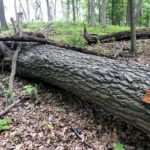
Log ready to be bucked up to firewood.
Losing a beautiful old tree is painful, but there is a time when the tree should be removed to prevent an injury, death, or damage. At Winding Pathways, we let even old weak trees stand as long as they are well away from the house or places where sit. But if the tree could fall and hit a parked car, house or barn we call a tree service and have it repurposed into firewood.
This Youtube video provides an excellent overview of live and dead trees, saving or cutting the appropriate trees. My Woodlot.















